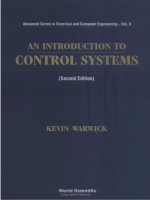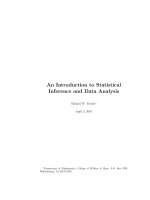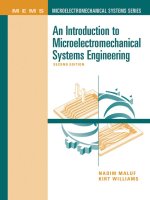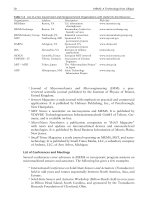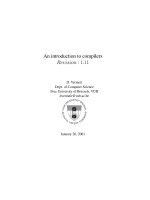An introduction to analytical atomic spectrometry
Bạn đang xem bản rút gọn của tài liệu. Xem và tải ngay bản đầy đủ của tài liệu tại đây (1.85 MB, 225 trang )
www.pdfgrip.com
Page iii
An Introduction to Analytical Atomic Spectrometry
Contributing Authors:
L. Ebdon
E.H. Evans
A.S. Fisher
S.J. Hill
University of Plymouth, UK
Edited by:
E.H. Evans
www.pdfgrip.com
Page iv
Copyright © 1998 by John Wiley & Sons Ltd,
Baffins Lane, Chichester,
West Sussex PO19 IUD, England
National 01243 779777
International (+44) 1243 779777
e-mail (for orders and customer service enquiries):
Visit our Home Page on
or http:// www.wiley.com
All Rights Reserved. No part of this publication may be reproduced, stored in a retrieval
system, or transmitted, in any form or by any means, electronic, mechanical, photocopying,
recording, scanning or otherwise, except under the terms of the Copyright, Designs and
Patents Act 1988 or under the terms of a licence issued by the Copyright Licensing
Agency, 90 Tottenham Court Road, London WIP 9HE, UK, without the permission in
writing of the publisher
Other Wiley Editorial Offices
John Wiley & Sons, Inc., 605 Third Avenue,
New York, NY 10158-0012, USA
WILEY -VCH Verlag GmbH, Pappelallee 3,
D-69469 Weinheim, Germany
Jacaranda Wiley Ltd, 33 Park Road, Milton,
Queensland 4064, Australia
John Wiley & Sons (Asia) Pte Ltd, 2 Clementi Loop #02-01,
Jin Xing Distripark, Singapore 129809
John Wiley & Sons (Canada) Ltd, 22 Worcester Road,
Rexdale, Ontario M9W IL1, Canada
Library of Congress Cataloging-in-Publication Data
An introduction to analytical atomic spectroscopy / contributing
authors, L. Ebdon . . . [et al.]; edited by E.H. Evans.
p. cm.
Includes bibliographical references and index.
ISBN 0-471-97417-X (alk. paper). — ISBN 0-471-97418-8 (pbk.:
alk. paper)
1. Atomic spectroscopy. I. Ebdon, L. II. Evans, E. Hywel.
QD96.A8158 1998
543'.0873 — dc21
97-31697
CIP
British Library Cataloguing in Publication Data
A catalogue record for this book is available from the British Library
ISBN 0 471 97417 X (cloth)
www.pdfgrip.com
ISBN 0 471 97418 8 (paper)
Typeset in 10/12 pt Palatino by Laser Words, Madras, India
Printed and bound in Great Britain by Biddles Ltd, Guildford, Surrey.
This book is printed on acid-free paper responsibly manufactured from sustainable
forestry, in which at least two trees are planted for each one used for paper production.
www.pdfgrip.com
Page v
Contents
Preface
ix
Acknowledgements
xi
1
Overview of Analytical Atomic Spectrometry
1
1.1 Historical
1
1.1.1 Optical spectroscopy
1
1.1.2 Mass spectrometry
3
1.2 Basic Instrumentation
4
1.2.1 Optical spectroscopy
4
1.2.2 Mass spectrometry
4
1.3 Basic Theory
6
1.3.1 Atomic absorption
6
1.3.2 Atomic emission
6
1.3.3 Atomic fluorescence
7
1.3.4 Atomic mass spectrometry
7
1.4 Practice
1.4.1 Calibration and analysis
1.4.2 Sensitivity and limit of detection
1.5 Interferences and Errors
1.5.1 Interferences
8
8
10
11
11
www.pdfgrip.com
1.5.2 Operator errors
1.6 Applications
13
14
1.6.1 Clinical, food and organic samples
14
1.6.2 Petrochemicals
14
1.6.3 Agricultural samples
15
1.6.4 Waters and effluents
15
1.6.5 Geochemical and mineralogical samples
15
1.6.6 Metals
15
www.pdfgrip.com
Page vi
2
Flame Atomic Absorption Spectrometry
17
2.1 Theory
17
2.2 Instrumentation
20
2.2.1 Sources
20
2.2.2 Flames
23
2.2.3 Sample introduction and sample atomization
29
2.2.4 Burner design
33
2.2.5 Spectrometers
34
2.3 Sensitivity and Limit of Detection
43
2.4 Interferences and Errors
43
2.4.1 Spectral interferences
46
2.4.2 Ionization interferences
46
2.4.3 Chemical interferences
47
2.4.4 Applications
50
3
Electrothermal Atomization
51
3.1 Historical Development
51
3.2 Heated Graphite Atomizers
54
3.3 Other Atomizers
57
3.4 Atomization Mechanisms
58
3.4.1 Thermodynamic considerations
58
3.4.2 Kinetic considerations
59
www.pdfgrip.com
3.5 Interferences
60
3.5.1 Physical interferences
61
3.5.2 Background absorption
61
3.5.3 Memory effects
61
3.5.4 Chemical interferences
61
3.6 Methods of Overcoming Interferences
63
3.6.1 Control of furnace temperature
63
3.6.2 The effect of the orientation of tube heating
63
3.6.3 Isothermal operation
64
3.6.4 Matrix modification
65
3.6.5 The STPF concept
66
3.7 Other Electrothermal Techniques
66
3.7.1 Furnace atomic non-thermal excitation spectrometry
(FANES)
67
3.7.2 Furnace atomization plasma emission spectrometry
(FAPES)
67
3.8 Applications
68
3.9 The Relative Merits of Electrothermal Atomization
69
3.9.1 Advantages of electrothermal atomization
69
3.9.2 Disadvantages of electrothermal atomization
70
www.pdfgrip.com
Page vii
4
Plasma Atomic Emission Spectrometry
4.1 Theory
73
73
4.1.1 Atomic transitions
73
4.1.2 Broadening
75
4.2 Excitation Sources
78
4.2.1 Flame sources
78
4.2.2 Plasma sources
78
4.2.3 Flames vs plasmas
79
4.3 Flame Atomic Emission Spectrometry
82
4.4 Inductively Coupled Plasma Atomic Emission Spectrometry
83
4.4.1 Plasma generation
83
4.4.2 Radiofrequency generators
86
4.4.3 Sample introduction
87
4.4.4 Excitation
92
4.4.5 Monochromators
93
4.4.6 Detectors
99
4.4.7 Data handling
103
4.4.8 Performance characteristics
103
4.4.9 Applications
107
4.5 Other Flame-like Plasma Sources
4.5.1 Microwave plasmas
108
108
www.pdfgrip.com
4.5.2 Direct current plasmas
110
4.6 Solid Sampling Plasma Sources
111
4.6.1 Arcs and sparks
111
4.6.2 Glow discharges
112
5
Inductively Coupled Plasma Mass Spectrometry
115
5.1 Sample Introduction
115
5.2 Ionization
116
5.3 Ion Sampling
118
5.4 Mass Analysis
120
5.4.1 Quadrupole mass analysis
120
5.4.2 Magnetic sector mass analysis
123
5.4.3 Resolution
124
5.5 Ion Detection and Signal Handling
125
5.6 Performance
128
5.7 Applications
130
5.7.1 Isotope ratio analysis
131
5.7.2 Isotope dilution analysis
134
www.pdfgrip.com
Page viii
6
Atomic Fluorescence Spectrometry
137
6.1 Theory
137
6.2 Instrument Design
139
6.3 Sources
140
6.4 Atomization
141
6.4.1 Flames
141
6.4.2 Electrothermal atomizer
142
7
Special Sample Introduction Techniques
145
7.1 Pulse Nebulization
145
7.2 Other Discrete Sampling Devices
146
7.3 Slotted Tube Atomizer
146
7.4 Flow Injection
146
7.5 Vapour Generation
147
7.5.1 Hydride generation
147
7.5.2 Cold vapour generation
151
7.5.3 Other vapour techniques
152
7.6 Chromatography
153
7.7 Solid Sampling Techniques
154
7.8 Nebulizers
155
Appendices
A Revision Questions
157
157
www.pdfgrip.com
B Practical Exercises
B.1 Calculations
161
B.2 Laboratory Exercises
163
B.3 Operation and Optimization of an Atomic Absorption
Spectrometer and Determination of Magnesium in Synthetic Human
Urine
163
B.4 Determination of Sodium in Soil Extracts by Atomic Emission
Spectrometry
167
B.5 Graphite Furnace Atomic Absorption Spectrometry
171
B.6 Speciation of Arsenic Compounds by Ion-exchange Highperformance Liquid Chromatography with Hydride Generation
Atomic Fluorescence Detection
173
B.7 Introduction to Isotope Dilution Inductively Coupled Plasma
Mass Spectrometry
176
C Bibliography
Index
161
183
187
www.pdfgrip.com
Page ix
Preface
This book is based on An Introduction to Atomic Absorption Spectroscopy by L. Ebdon, which was
published in 1982. Since then there have been a number of significant developments in the field of
Atomic Spectrometry: inductively coupled plasma atomic emission spectrometry (ICP -AES) has
become an established technique, and is used in most analytical laboratories; the spectacular rise to
prominence of inductively coupled plasma mass spectrometry has occurred, with a concomitant
increase in the speed and quantity of data production, and the sensitivity of analyses. To reflect these
changes we have chosen the more generally applicable title An Introduction to Analytical Atomic
Spectrometry for this book. While much of the original text from An Introduction to Atomic Absorption
Spectroscopy has been retained, the chapter on Plasma Atomic Emission Spectrometry has been
expanded to reflect the importance of ICP-AES, and a chapter on Inductively Coupled Plasma Mass
Spectrometry has been included. A thorough treatment of Flame Atomic Absorption Spectrometry
(FAAS) has been retained because a thorough understanding of this technique will form the basis of
understanding in the whole field of analytical atomic spectrometry. Just as importantly, FAAS is
available in most teaching laboratories, whereas ICP-AES and ICP-MS are not.
The rationale of this book remains the same as that of its forerunner. The book is intended to
complement undergraduate and postgraduate courses in analytical chemistry, and to aid in the
continuing professional development of analytical chemists in the workplace. The problems of release
from work to engage in training are even more acute now than they were in 1982, despite the even
greater necessity for lifelong learning and continuous upgrading of skills. Even in full-time education
the situation has changed. The number of students studying for first and second degrees has increased,
and mature students are returning to education in greater numbers than ever before, hence distance and
self-learning have become an even more vital component in any course of study.
www.pdfgrip.com
Page x
Keywords are highlighted throughout the text, and there are self-assessment questions at intervals
throughout. Chapter 1 is a brief overview of theory and instrumentation. A short treatment of good
laboratory practice and sample preparation is included. No amount of words can do justice to these
issues, so the discussion is limited to the main points, with the onus being on the tutor to impress upon
the student the importance of quality assurance in the practical environment of the laboratory itself!
Flame and electrothermal atomic absorption spectrometry are dealt with in Chapters 2 and 3,
respectively, revised to take account of recent developments. Plasma emission spectrometry is dealt
with in Chapter 4, with centre stage going to the inductively coupled plasma. Inductively coupled
plasma mass spectrometry is the subject of Chapter 5. Two short Chapters, 6 and 7, then deal with
atomic fluorescence spectrometry and special sample introduction methods. In each of the chapters
there are sections on theory, instrumentation, interferences and applications. Several appendices contain
revision questions, practical and laboratory exercises and a bibliography.
The book can be used as a self-learning text but it is primarily meant to complement a lecture or
distance learning course, and is indeed used in this capacity at Plymouth for undergraduate and
postgraduate lectures, and for short courses. Basic theory is included because this is vital to the
understanding of the subject; however, excessive theoretical discourse has been avoided, and the
emphasis is firmly on the practical aspects of analytical atomic spectrometry.
E. HYWEL EVANS
PLYMOUTH
JULY 1997
www.pdfgrip.com
Page xi
Acknowledgements
Thanks to all those, colleagues and students, who involved themselves in discussion over many years—
their essence is distilled in this book. Also, many thanks to Siân for proof-reading and typing, and to
Gavin for practical B.6.
www.pdfgrip.com
Page 1
1
Overview of Analytical Atomic Spectrometry.
1.1 Historical
1.1.1 Optical Spectroscopy
Spectroscopy is generally considered to have started in 1666, with Newton's discovery of the solar
spectrum. Wollaston repeated Newton's experiment and in 1802 reported that the sun's spectrum was
intersected by a number of dark lines. Fraunhofer investigated these lines—Fraunhofer lines—further
and, in 1823, was able to determine their wavelengths.
Early workers had noted the colours imparted to diffusion flames of alcohol by metallic salts, but
detailed study of these colours awaited the development of the premixed air-coal gas flame by Bunsen.
In 1859, Kirchhoff showed that these colours arose from line spectra due to elements and not
compounds. He also showed that their wavelengths corresponded to those of the Fraunhofer lines.
Kirchhoff and Fraunhofer had been observing atomic emission and atomic absorption, respectively.
Atomic absorption spectroscopy (AAS), atomic emission spectroscopy (AES) and later atomic
fluorescence spectroscopy (AFS) then became more associated with an exciting period in astronomy
and fundamental atomic physics. Atomic emission spectroscopy was the first to re-enter the field of
analytical chemistry, initially in arc and spark spectrography and then through the work of Lunegardh,
who in 1928 demonstrated AES in an air-acetylene flame using a pneumatic nebulizer. He applied this
system to agricultural analysis. However, the technique was relatively neglected until the development
of the inductively coupled plasma as an atom cell, by Greenfield in the UK and Fassel in the USA,
which overcame many of
www.pdfgrip.com
Page 2
the problems associated with flames, arcs and sparks. The term emission spectroscopy is applied to the
measurement of light emitted from flames or plasmas by chemical species after the absorption of energy
as heat or as chemical energy (i.e. chemiluminescence). If only the emission from atoms is observed,
the term atomic emission spectroscopy is preferred.
Atomic absorption spectroscopy is the term used when the radiation absorbed by atoms is measured.
The application of AAS to analytical problems was considerably delayed because of the apparent need
for very high resolution to make quantitative measurements. In 1953, Walsh brilliantly overcame this
obstacle by the use of a line source, an idea pursued independently by Alkemade, his work being
published in 1955.
The re-emission of radiation from atoms which have absorbed light is termed atomic fluorescence. In
1962, Alkemade was the first to suggest that AFS had analytical potential, which was demonstrated in
1964 by Winefordner.
These three types of spectroscopy are summarized in Fig. 1.1. The horizontal lines represent different
energy levels in an atom. E0 is the term
Figure 1.1
Summary of AES, AAS and AFS.
www.pdfgrip.com
Page 3
used for the lowest energy level, which is referred to as the ground state and therefore all practical
absorption measurements originate from atoms in the ground state, as do virtually all practical
fluorescence measurements. Ei and Ej refer to other energy levels, Ej being higher (greater energy) than
Ei. A solid vertical line refers to a transition involving the absorption or emission of radiation as energy.
The wavy line refers to a non-radiative transition.
The energy of the radiation absorbed or emitted is quantized according to Planck's equation (Eqn. 1.1).
These quanta are known as photons, the energy of which is proportional to the frequency of the
radiation.
where h = Planck's constant (6.62 x 10-34 J s), v = frequency, c = velocity of light (3 x 10 8 m s-1) and λ =
wavelength (m).
1.1.2 Mass Spectrometry
After the existence of different isotopic forms of the elements was first demonstrated by Thompson,
the technique of mass spectrometry is considered to have begun with Aston and Dempster, who
reported the accurate measurements of ionic masses and abundances in 1918-19. From these
beginnings, using magnetic and electric fields to separate ions of different mass, mass spectrometry has
grown into a major technique for the analysis of organic and inorganic compounds and elements. The
development of instruments based on quadrupole, time-of-flight, and ion trap mass analysers has taken
the technique from the research laboratory into everyday use as an analytical instrument.
In magnetic/electric sector mass analysers, ions are deflected in a magnetic field, the extent of
deflection depending on their mass-to-charge ratio (m/z). If all the ions have the same charge then the
deflection is dependent on their relative masses, hence a separation can be effected. In quadrupole
mass analysers the ions are subjected to a radiofrequency (RF) field, which is controlled so that only
one particular m/z can pass through it. Hence the quadrupole acts like a mass filter, and the field can be
varied so that ions of consecutively higher m/z pass through sequentially. An ion trap acts in a similar
way except that the ions are first trapped inside it, then let out sequentially. Time-of-flight mass
analysers are essentially long tubes along which the ions pass. Ions of low mass have a higher velocity
than ions of higher mass so, if a pulse of ions is introduced into one end of the tube, the light ions will
arrive at the other end before the heavy ions, thereby effecting a separation.
www.pdfgrip.com
Page 4
Mass analysis is a relatively simple technique, with the number of ions detected being directly
proportional to the number of ions introduced into the mass spectrometer from the ion source. In
atomic mass spectrometry the ion source produces atomic ions (rather than the molecular ions formed
for qualitative organic analysis) which are proportional to the concentration of the element in the
original sample. It was Gray who first recognized that the inductively coupled plasma would make an
ideal ion source for atomic mass spectrometry and, in parallel with Fassel and Houk, and Douglas and
French developed the ion sampling interface necessary to couple an atmospheric pressure plasma with
a mass spectrometer under vacuum.
1.2 Basic Instrumentation
1.2.1 Optical Spectroscopy.
Figure 1.2 shows the basic instrumentation necessary for each technique. At this stage, we shall define
the component where the atoms are produced and viewed as the 'atom cell'. Much of what follows will
explain what we mean by this term. In atomic emission spectroscopy, the atoms are excited in the atom
cell also, but for atomic absorption and atomic fluorescence spectroscopy, an external light source is
used to excite the ground-state atoms. In atomic absorption spectroscopy, the source is viewed directly
and the attenuation of radiation measured. In atomic fluorescence spectroscopy, the source is not
viewed directly, but the re-emittance of radiation is measured.
Current instrumentation usually uses a diffraction grating as the dispersive element and a
photomultiplier as the detector, although solid-state detectors are becoming more widespread.
Historically, data collection and manipulation were effected by means of analogue meters, chart
recorders, digital displays and paper print-outs. However, the advent of the microcomputer now allows
data to be stored electronically, calibrations performed and concentrations calculated and reported on a
user-defined form.
1.2.2 Mass Spectrometry
Figure 1.2 shows the basic instrumentation for atomic mass spectrometry. The component where the
ions are produced and sampled from is the 'ion source'. Unlike optical spectroscopy, the ion sampling
interface is in intimate contact with the ion source because the ions must be extracted into the vacuum
conditions of the mass spectrometer. The ions are separated with respect to mass by the mass analyser,
usually a quadrupole, and literally counted by means of an electron multiplier detector. The ion signal
for each
www.pdfgrip.com
Page 5
Figure 1.2
Basic instrumentation systems used in analytical atomic spectrometry.
www.pdfgrip.com
Page 6
mass is stored in a multi-channel analyser and output to a microcomputer for data manipulation.
1.3 Basic Theory
A summary of the basic theory underlying the main atomic spectrometric techniques is given below.
For a more thorough discussion, refer to the individual chapters.
1.3.1 Atomic Absorption
Atomic absorption is the absorption of light by atoms. An atom has several energy levels. Under normal
circumstances, most atoms will be in the ground (unexcited) state. For the energy levels E0 (ground
state) and Ej (excited state), a transition from E0 → Ej represents an absorption of radiation (Fig. 1.1).
For atomic absorption to occur, light of the correct wavelength (energy) is absorbed by ground-state
electrons, promoting them to a higher, excited state. The intensity of the light leaving the analytes is
therefore diminished. The amount by which it is diminished is proportional to the number of atoms that
were absorbing it. A situation analogous to the Beer-Lambert law is therefore obtained. This law is
expressed as
where A is absorbance, I0 is the incident light intensity, I the transmitted light intensity, kv is the
absorption coefficient and l is the path length.
It can be shown that kv and hence A, are proportional to atom concentration, and the plot of absorbance
against atom concentration is a straight line.
1.3.2 Atomic Emission
The intensity Iem of a spontaneous emission of radiation by an atom is given by the equation
where Aji is the transition probability for spontaneous emission, h is Planck's constant, vji is the
frequency of radiation and Nj the number of atoms in the excited state.
It can be shown (see Chapter 4) that Nj , and hence Iem , are proportional to the atom concentration, and
for low concentrations the plot of emission intensity against atom concentration is a straight line.
www.pdfgrip.com
Page 7
1.3.3 Atomic Fluorescence.
In atomic fluorescence spectroscopy an intense excitation source is focused on to the atom cell. The
atoms are excited then re-emit radiation, in all directions, when they return to the ground state. The
radiation passes to a detector usually positioned at right-angles to the incident light. At low
concentrations, the intensity of fluorescence is governed by the following relationship:
where If is the intensity of fluorescent radiation, C is the concentration of atoms, k is a constant, I0 is
the intensity of the source at the absorption line wavelength and Φ is the quantum efficiency for the
fluorescent process (defined as the ratio of the number of atoms which fluoresce from the excited state
to the number of atoms which undergo excitation to the same excited state from the ground state in unit
time).
The intensity of fluorescence is proportional to the concentration of atoms, and hence the concentration
of the element in the sample, so a plot of concentration against fluorescence will yield a straight line.
There are several different types of atomic fluorescence as follows:
(i) Resonance fluorescence.
(ii) Direct line fluorescence.
(iii) Stepwise line fluorescence.
(iv) Thermally assisted fluorescence.
These are described in more detail in Chapter 6. Resonance fluorescence, i.e. the excitation and
emission are at the same wavelength, is most widely used. The others have very limited use
analytically.
1.3.4 Atomic Mass Spectrometry
The degree of ionization of an atom is given by the Saha equation:
where ni ne and na are the number densities of the ions, free electrons and atoms, respectively, Z i and Za
are the ionic and atomic partition functions, respectively, m is the electron mass, k is the Boltzmann
constant, T is the temperature, h is Planck's constant and Ei is the first ionization energy.
In atomic mass spectrometry, the rate of production of ions is measured directly. This is proportional to
the concentration of ions, and hence atoms. A plot of ion count rate against atom concentration will
therefore yield a straight line.
www.pdfgrip.com
Page 8
1.4 Practice
1.4.1 Calibration and Analysis
Spectroscopic techniques require calibration with standards of known analyte concentration. Atomic
spectrometry is sufficiently specific for a simple solution of a salt of the analyte in dilute acid to be
used, although it is a wise precaution to buffer the standards with any salt which occurs in large
concentration in the sample solution, e.g. 500 µg ml -1 or above. Calibration curves can be obtained by
plotting absorbance (for AAS), emission signal (for AES), fluorescence signal (for AFS) or ion count
rate (for MS) as the dependent variable against concentration as the independent variable. Often the
calibration curve will bend towards the concentration axis at higher concentrations, as shown in Fig.
1.3. In AAS this is caused by stray or unabsorbable light, in AES and AFS by self-absorption and in
MS by detector overload. As the slope decreases, so will precision and it is preferable to work on the
linear portion of the calibration known as the working curve. The best results are obtained when the
standards are introduced first in ascending order of concentration, and then in descending order, each
time 'bracketing' the samples with standards of immediately lower then higher concentration when
ascending, and the reverse when descending. Modern instruments will normally have computer
software for effectively performing the calibration. Samples should not lie off the
Figure 1.3
Typical calibration curve obtained in atomic spectrometry. At high concentrations
the curve will bend towards the concentration axis; for explanation, see text.
www.pdfgrip.com
Page 9
calibration curve, i.e. it must never be more concentrated than the strongest standard and preferably not
more dilute than the weakest.
The method of standard additions is a useful procedure for checking the accuracy of a determination
and overcoming interferences when the composition of the sample is unknown. It should be noted that
the method cannot be used to correct for spectral interferences and background changes. At least
three aliquots of the sample are taken. One is left untreated; to the others known additions of the
analyte are made. The additions should preferably be about 0.5x, x and 2x, where x is the concentration
of the unknown. It should also be noted that the volume of the addition should be negligible in
comparison with the sample solution. This is to prevent dilution effects
Figure 1.4
Method of standard additions.
www.pdfgrip.com
Page 10
which would render the standard addition process invalid. The solutions are then aspirated and the
curve shown in Fig. 1.4 is plotted. The curve is extrapolated back until it crosses the x-axis, giving the
concentration in the unknown. A standard addition curve parallel to the calibration curve is indicative
(but not conclusive) of the absence of interference.
Accuracy of analyses should be checked using certified reference materials (CRMs). These are
materials ranging from botanical and biological to environmental and metallic samples that have been
analysed by numerous laboratories using several independent techniques. As a result, 'agreed' values of
the sample's elemental composition are produced. Therefore, by matching a CRM with the sample to be
analysed, the validity of the analysis can be verified. If the result of the analysis of the CRM agrees
closely with the certified value, the analyst can have more confidence that the sample preparation
procedure is adequate and that the results obtained for the samples are accurate. Such samples may also
be used as check samples. These should be analysed every 5-10 real samples. In this way, instrument
drift may be detected at an early stage and re-calibration performed as necessary.
Q. What are the advantages of the method of standard additions?
1.4.2 Sensitivity and Limit of Detection
The power of detection of any atomic spectrometric method of analysis is conveniently expressed as the
lower limit of detection (l.o.d) of the element of interest. The l.o.d. is derived from the smallest
measure x which can be accepted with confidence as genuine and is not suspected to be only an
accidentally high value of the blank measure. The value of x at the 99.7% confidence level (so called 3s
level) is given by
where Xbl is the mean and sbl is the estimate of the standard deviation of the blank measures. The
deviations of a number of measurements from the mean of those measurements will show a
distribution about the mean. If that distribution is symmetrical (or to be more precise Gaussian), this
is termed a normal error curve. Hence there is always some uncertainty in any measurement. The
standard deviation is a useful parameter derived from the normal error curve. An estimate of the true
standard deviation s of a finite set of n different readings can be calculated from


